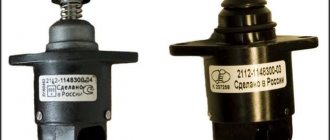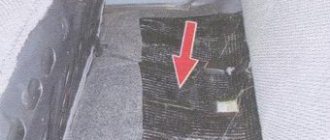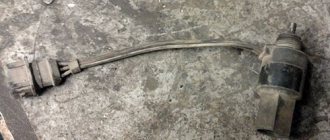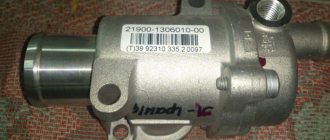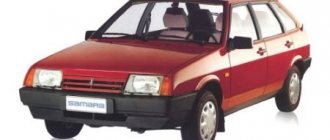Candles
First of all, find out if there is a spark at all. The weakness of the latter allows you to start the engine while it remains hot, but it does not work when it is cold.
Unscrew the spark plug, place it against ground and crank the starter. If there is a spark, then there is probably a problem in the fuel system. We will tell you about it later.
It is necessary to do otherwise when the unscrewed spark plug works properly, but it turns out to be wet. Here you should check the timing belt. The latter sometimes jumps off, which disrupts the correct gas distribution and, accordingly, the VAZ engine does not want to start.
If you see that the spark plugs are filled with fuel, then perhaps this very circumstance is preventing you from starting the engine. Dry them with a burner or on a gas stove burner. When they turn out to be wet again during the next attempt, you will have to find out why this happened.
If there is no spark, the cause is sought further. It often lies in problems:
- crankshaft pulley or sensor that controls its position (DCPV);
- computer.
In most cases, the VAZ model 2109 injector does not want to start precisely because of the failure of the DPKV. Failure of other sensors does not prevent the engine from starting, it will simply not work correctly.
First, check whether the connector leading to it is intact and whether the wires are in good condition. It is the destruction or contamination of these elements that most often interferes with the normal operation of the DPKV, while the device itself is reliable.
To test the sensor, just hold a piece of metal close to it and measure the output voltage. It will fall if the piece of iron is taken away, and rise when it is brought close.
Another reason why a VAZ may not start is the crankshaft pulley. The disadvantage of this unit is that its teeth are partially made of rubber, which means they can come off or even scroll. This affects the sensor readings, and the computer, guided by them, does not want to supply voltage to the spark plugs. It’s not difficult to check - remove the casing from the timing belt (inspect it at the same time), and then examine the pulley.
There is a high probability that there is no spark due to a faulty ignition. First you should make sure that the connector leading to it is intact. Installing a known-good module on a Lada that does not want to start will allow you to confirm your suspicions.
It is imperative to inspect all wires. A break in them, even with working devices, often leads to the inability to start the engine.
This is interesting: Electronic gas pedal - how to fix the “assistant”?
Reasons for tripling
Strong engine vibrations are the first symptom of tripping. At the same time, misfires, exhaust problems and other symptoms may occur. Troubleshooting can be permanent or appear occasionally; it can appear during heavy engine loads or during different temperature conditions.
Engine failure during tripping is distinguished primarily by the fact that the combustion process of fuel assemblies in the cylinders is disrupted. Accordingly, this is accompanied by strong vibrations. However, it is fundamentally wrong to consider the appearance of increased vibrations as the only sign of tripling, since there are a number of reasons when the same thing happens.
The main problems that contribute to tripling include the following.
- Excessive air in the system.
- Rich FA.
- Problems with the ignition system.
- Wear of engine elements, which is accompanied by a drop in compression.
Thus, the power unit begins to triple as a result of either a mismatch in the composition of the fuel assembly, or untimely ignition of the mixture, or the inability to ignite the fuel. Other types of violations are also possible.
To determine the specific cause of tripling, you need to narrow the search, thereby leaving the only correct reason.
- They usually start with the fuel system. The air supply is then analyzed. In some cases, this is caused by the failure of certain sensors.
- Ignition failure is an equally common cause of power unit tripping. Added to this is a weak spark from the spark plugs. It is recommended to always check the latter as soon as tripping or other ignition-related problems occur. The candles are simply unscrewed and inspected for defects, their color is analyzed, etc. For example, if the insulator of a candle is damaged, then smoke is clearly visible in this place.
- Armor wiring testing. If the engine shakes occasionally in wet weather, this is generally an additional symptom that shows tripping due to wires. The signs go away as soon as the engine warms up and reaches its operating temperature. It is recommended to pay special attention to rubber insulators, which tend to dry out and crack over time.
Attention. Rubber caps for armored wiring often deteriorate after repair work. It can be difficult to visually determine a breakdown until the cap is removed.
Ignition
The ignition module is a unit that comes into question after all the checks have been carried out. It is the bobbin that can become the culprit for the power unit tripping at idle or in other modes. To check the coil you need to do this:
- Unscrew the spark plug, then apply it to the ground (any part of the body).
If the spark is good, its color is of high quality, and a characteristic crackling sound is heard, then the serviceability of the reel is not questioned. On the contrary, if there is no spark, or it is of poor quality, the module must be replaced, and thus it will be possible to “cure” the tripping.
It's not very often that a switch goes bad, but it does happen. It must be checked and, if anything, replaced.
Elimination methods
The main reason that the engine may not gain speed is the formation of an air-fuel mixture. So, the engine does not receive the correct ratio of gasoline and air, which affects the operation of the power unit and the burning mixture does not sufficiently spin the crankshaft, which drives the wheels.
Let's look at the basic diagnostic operations and repair methods.
Bad "fuel"
First of all, it is necessary to understand what quality of gasoline is poured into the system and whether it is possible for it to burn correctly and completely. This will determine not only whether the crankshaft can spin up, but also whether the power system is clogged.
Typically, the main indicator of gasoline quality is the condition of the fuel filter. If it clogs too often, it is recommended to change the fuel supplier. To fix the problem, it is necessary to clean the entire fuel supply system, from the fuel tank to the injectors. Also, it is worth diagnosing and cleaning the piston group, where most likely the pistons already have carbon deposits.
Ignition system malfunctions
More than once, the reason that the engine does not pick up speed well has been the ignition unit. Failure of spark plugs or high-voltage wires is a direct sign of problems of various types. Carrying out diagnostic operations is quite simple. The spark plugs are unscrewed and inspected for cracks and carbon deposits.
If there is no visible damage, then it is worth checking the performance on a special spark plug stand. If inoperative spark plugs are found, it is recommended to change them, first setting the gap.
High-voltage wires are removed from the vehicle and checked using a tester. If the resistance is more or less than 5 ohms, then this is the reason.
It is worth considering the fact that high-voltage wires must be replaced in sets.
Formation of the air-fuel mixture
To form an air-fuel mixture, two things are needed - fuel and air. In this context, a blockage in one of the systems will lead to the combustible mixture being formed incorrectly, which will affect the operation of the power unit.
As for the clogging of the injection system, it is often the injectors. Usually, to cure a malfunction, it is enough to simply clean the elements, but not always. It happens that the injectors are too clogged and the elements will need to be replaced. Many car enthusiasts do not know that this part is dismountable and it is enough to change the nozzles, which have a much lower price.
Clogging of the air supply system occurs when the unit is not maintained in a timely manner. The first place to look is the air filter. In this context, not enough air enters the engine cylinders, which leads to incomplete combustion of gasoline, kinetics that are not enough to put enough pressure on the pistons and spin the crankshaft.
The next element that is recommended to be checked is the throttle valve. A clogged or jammed element can lead to the effect described above. You can clean the unit yourself using a regular carburetor cleaner.
Piston group
More than once, the cause of engine malfunction was carbon deposits in the piston group. It can be eliminated using special automotive chemicals or folk methods. But, as practice shows, this does not last long, and the engine has to be overhauled. Also, it is worth noting that carbon deposits will be not only on the piston group, but also on the valves.
A combination of factors can become the underlying cause of a malfunction and the advisability of a major overhaul.
Electronics
The only element that is almost impossible to diagnose at home is electronics. So, a malfunction of one of the sensors or malfunctions in the electronic engine control unit will lead to improper operation of the engine. To diagnose and fix the problem, you need to contact a specialist.
Often, many engine owners turn to a tuner to carry out chip tuning of the VAZ 2109 engine. This will eliminate defects in the factory firmware, as well as reduce consumption or increase the power of the power unit.
This is interesting: Window lifters on the VAZ 2107 and VAZ 2110 - we drive like a breeze!
Compression reduction
A drop in this parameter may indicate a malfunction with the internal combustion engine or wear of its elements. Over time, valves and pistons burn out, resulting in compression.
Engine compression is directly related to throttle. The cylinder or cylinders stop working. It is noteworthy that you need to proceed to checking the compression at the very last moment, when all other possible causes have already been checked. The fact is that you will have to interfere with the installed engine system, open the engine, and only a qualified mechanic can do this. Any incorrect action can damage the power unit.
The internal elements of the engine may break, for example, if the timing chain breaks. True, this does not happen often, but the problem should not be ruled out. A compression test will help determine the condition of the pistons and rings. For example, if the readings are low during measurement, you need to pour a little oil into the cylinder and then check again. If the compression indicator increases, there is definitely a malfunction in the piston group.
The reason for low compression in the engine
Low compression is usually the result of some kind of mechanical failure. For example, this could be a failure of the timing belt, which either broke or slipped by one “tooth.” Also, a low compression ratio may be due to wear and tear on the engine piston system itself.
As a rule, over time, when operating a car, the piston rings or cylinder block walls wear out in the engine, which of course leads to a decrease in compression in the combustion chamber. If, when you try to start the engine, there is fuel in the exhaust pipe, then the likely cause of failure of the power unit is damage to the piston system (crack, etc.).
To check the piston rings you need to do a compression test along with the engine oil . To do this, before installing the compression gauge on the spark plug hole, add a little engine oil to the cylinder. After this, install a compression gauge and measure the compression ratio in the cylinder. If it turns out that the compression ratio with the addition of engine oil to the cylinder has become greater than during the first “dry” measurements, then most likely a large gap has appeared between the piston rings and the engine cylinder wall due to their wear, which leads to a decrease in compression. The fact is that when you add oil, you cover this very gap with an oil layer for a short time, which ultimately leads to increased compression in the cylinder.
VAZ won’t start – what to do?
In general, diagnosing malfunctions of the controller (computer) and control system sensors, as well as the VAZ-2109 injector itself, is not much different from similar work for other cars. But due to the peculiarities of the “nine” control system, experienced owners of this car recommend the following solutions.
Most often, the injection “nine” does not start in winter. In this case, it is advisable to warm up and even recharge the battery - perhaps due to loss of capacity due to low temperature, it is not able to spin the engine shaft well.
Another “folk” method that helps is supplying air to the engine filter through a hairdryer. At the same time, heated air will flow into the cylinders. Many people claim that the VAZ starts right away.
Another possible reason: as a result of prolonged unsuccessful attempts to start, the spark plugs were filled with gasoline. In this case, it is recommended to try to start the car with the gas pedal pressed all the way to the floor - the spark plugs should dry out and the car will start. If this does not help, then unscrew the spark plugs and check for the presence of a spark. If it is not there, then either the spark plugs or the ignition system are faulty.
Electrical wiring problems
Listen to whether the fuel pump is running when the ignition is turned on. If there is no characteristic sound, then check the fuses on the VAZ 21093 (injector). Namely, the one that is responsible for supplying power to the fuel pump and its electromagnetic relay. It would also be a good idea to check the presence of power to all sensors in the system. Check all vehicle wiring for breaks. But if everything is in order, and the car does not start, then most likely there is a glitch in the software installed in the ECU. In this case, you will have to contact a service station for a complete diagnosis and firmware update of the microcontroller.
Other problems
Both on the carburetor and on the injector, the main reason that prevents the engine from starting is problems with the starter. If it does not rotate, then you will have to figure out why. Possible breakdowns:
- winding break;
- solenoid relay failure;
- poor contact in the wiring;
- discharged battery.
Also, the car may not start due to lack of gasoline.
The ignition coil and lock will have to be checked if nothing else helps. When it turns out that the problem is in the first one, it is removed and replaced with a new one. In the second case, first of all, look to see if the wire has broken somewhere.
In the ignition system, the distributor is also a vulnerable element. Remove the cover from it - if it is damaged, replace it. You need to do the same with the slider and hall sensor.
In winter, condensation sometimes freezes in the fuel rail. Warming up with a hairdryer or blowing with a compressor helps.
Muffler
Sometimes an injection car does not want to start due to shedding of the catalyst in the muffler. It serves to reduce harmful emissions and is installed in accordance with current environmental legislation on all cars.
When the catalyst crumbles, the gases cannot escape normally, which means that the car will not move, since the computer will not allow it to start. It is not difficult to check this possibility - unscrew the muffler mount so that the exhaust comes directly from the resonator. If this helps, then change the catalyst.
Checking injectors and timing belt
When there is a spark and its color is bright bluish, check the fuel supply: turn out the injectors and turn the engine shaft with the starter. The fuel should be sprayed from the nozzle in a uniform cone-shaped “torch”. If instead the injector pours gasoline or splashes it, then it is clogged.
If the tested components are working, then look at the timing belt. Owners of the injection “nine” have more than once encountered the situation of the belt slipping by several teeth. In winter, this can happen when starting a cold engine when the camshaft rotates heavily. To check, look at the timing mark. If it matches, check the crankshaft sensor and its wire (sometimes it comes off). Then the remaining sensors are checked.
Timing Belt
Anything can happen to this element. Firstly, the belt tends to break, and this happens at the most inopportune moment. It is worth noting that on 1.5-liter engines, fortunately, a broken belt does not end with bending the valves or repairing the cylinder head. but more trouble may arise if the timing belt simply jumped 1-2 teeth. This happens when the belt is loose. To make sure the settings are correct, you need to see if the marks on the camshaft and crankshaft match. But if the VAZ 21093 engine (injector) does not start, be sure to check the crankshaft position sensor and its connection wire. This device must first be diagnosed.
Ignition system malfunctions
One of the most common reasons why tripping occurs is the lack of a spark igniting the air-fuel mixture in the combustion chamber. There can be two specific malfunctions:
- failure of the corresponding spark plug;
- malfunction of the high-voltage wire leading to this spark plug.
Unscrew the corresponding spark plug and inspect it. The presence of soot, oil, or varnish deposits indicates abnormal operation of the spark plug and its imminent failure. A common reason for spark plug failure is poor fuel quality. This affects the operation of all four spark plugs, but when one of them fails, the engine begins to stall. It turns out that low-quality fuel may be an indirect cause of engine tripping.
It is not recommended to check the operation of the spark plug visually, by the presence of a spark jumping in the working gap while the engine is running. Even the presence of a spark at atmospheric pressure in the open air does not provide an absolute guarantee of adequate operation of the spark plug in the cylinder. And the lack of a spark is not necessarily associated with the failure of the spark plug; it could be a high-voltage wire. The wires are checked to ensure that the actual resistance matches the nominal resistance indicated on its insulation.
High-voltage wires are not replaced one at a time. If one fails, the entire set must be replaced.
Injectors: diagnostics
When it has been determined that there is a spark between the electrodes (and it is bright blue), the gaps are normal, but the engine still does not start, you need to check the injectors. These are devices that inject a fuel-air mixture into the combustion chambers of each engine cylinder. If the VAZ 21093 engine (injector) does not start, the likelihood that the injectors are malfunctioning is extremely high.
To check the fuel injectors, you will need to have diagnostic equipment. But this is for an accurate check. To, as they say, “by eye” determine serviceability, you can remove the nozzle and connect it to the power supply. The ideal form of spraying the air-fuel mixture is a cone-shaped torch. And if fuel flows or drips with difficulty from the nozzle, we can say that contamination has occurred. Cleaning the spray nozzles will help you in this case.
VAZ engine injector: control system diagnostics
Before touching upon general issues of diagnosing the control system, it is worth getting acquainted with the controller lamp
If a malfunction occurs while driving the car, the controller will detect it and notify the driver using “CHECK ENGINE”, while storing in its memory the necessary codes about the nature of the malfunction. With their help, the process of diagnosis and subsequent repair of the fuel injection system will be facilitated. It is the controller that is able to coordinate the operation of VAZ sensors and systems that are part of the general composition of all fuel injection units.
A few words about the DST-2M digital tester.
It is used to diagnose the engine injection control system. It is worth remembering that only a competent specialist can make the correct diagnosis. No matter how much an inexperienced mechanic strives to automate the process of diagnosing a car, having the necessary tools, he will not succeed without certain skills, which can in some cases aggravate an already difficult situation.
Diagnostics includes the following steps:
- checking the fuel supply system, the operability of all sensors, actuators and the ignition system;
- reading fault codes;
- compression measurement;
- data monitoring of the entire control system.
Once the injector has been diagnosed, the entire range of necessary services becomes clear if it is associated with a failed electronic system responsible for the performance of the engine.
Battery diagnostics
If the car is parked for a long time, the battery loses charge and loses voltage. The voltage sags so that ignition simply does not occur. You can diagnose the battery using a multimeter.
To do this you need:
- Open the hood;
- Set the multimeter mode to measure voltage up to 20 V;
- Touch the multimeter probes to the battery contacts.
The voltage should be 12.6 V. If the output voltage is less than this value, then this indicates a problem with the battery. A desirable action would be to check the density of the electrolyte. It is worth checking absolutely all contacts. First of all, you need to check them with a multimeter on the starter.
In an urgent case, when the VAZ 2109 needs to be started and started immediately, you need to turn on the headlights, thereby increasing the voltage on the battery. This activates the battery electrolyte.
In the case when the VAZ 2109 does not start on the injector, even with a charged battery. The reason may be in its terminals. It is worth checking for oxidation on them. This is why the VAZ 2109 does not start on the injector. A white coating forms on the terminals; it needs to be cleaned off with sandpaper.
VAZ 2109 injector controller
The controller receives the necessary information from the sensors, then makes calculations: based on them, it independently issues commands to the actuators. This device is quite reliable. One problem: it is afraid of large surges in on-board voltage. This can happen when the generator malfunctions or the starter sticks while the engine is running; sometimes the process of “lighting” another car or the use of a low-quality starting charger is to blame.
As soon as malfunctions occur, the controller immediately detects them, notifies the driver with the above-mentioned lamp, and stores the codes. Under his control, the injectors try to work smoothly, as does the ignition system.
The injectors turn on in pairs, but this depends on the type of controller itself. An interesting fact is that pairs of injectors tend to turn on alternately, approximately 180° from the crankshaft rotation. This is called double synchronous injection, but sequential operation is possible. An idle spark is provided for the system: 16-valve engines are an exception. They are already equipped with personal ignition coils for each spark plug.
This process occurs as follows: high-voltage pulses are applied to a specific pair, and the formation of a working spark occurs in the cylinder on the compression stroke and on the exhaust stroke. Otherwise, an idle spark will form. In this case, a small amount of energy is required for the cylinder during the exhaust stroke, and the rest of it is used during the compression stroke. This is how the process of ensuring normal sparking and unhindered ignition of the fuel mixture occurs. The whole process can be repeated if the cylinders decide to switch roles unexpectedly.
The controller controls not only the fuel supply, but also the energy accumulation time and ignition timing. This concerns the crankshaft rotation speed in idle mode, the uninterrupted operation of the electric fuel pump, the tachometer and the warning lamp, which is located on the VAZ instrument panel, the cooling system, and the cabin air conditioning compressor clutch. The device generates certain speed signals to the trip computer, regulates fuel consumption, and maintains the required stereochemical ratio (gasoline-air as 1:14.7).

